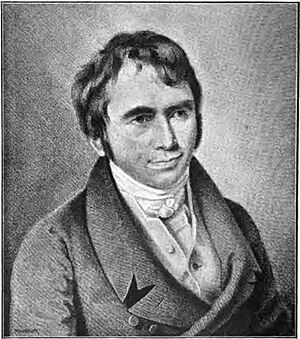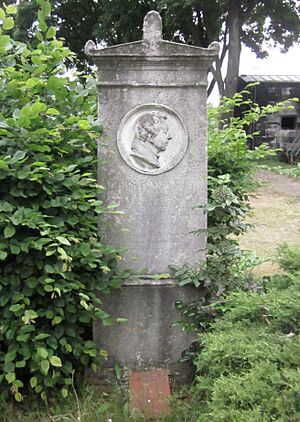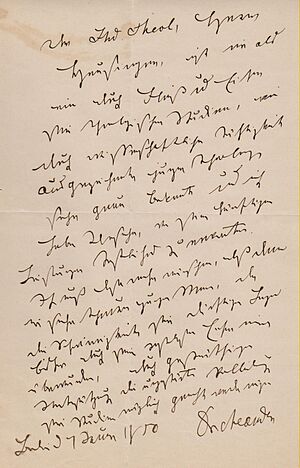August Neander facts for kids
Johann August Wilhelm Neander (born January 17, 1789 – died July 14, 1850) was an important German theologian and church historian. A theologian is someone who studies religion, and a church historian studies the history of the Christian church.
Contents
Early Life and Education
Neander was born in Göttingen, Germany, and his birth name was David Mendel. His father, Emmanuel Mendel, was a Jewish peddler, someone who travels around selling goods. When Neander was very young, his parents separated. He moved with his mother to Hamburg.
After finishing a type of school called a grammar school (the Johanneum), he went to another school called a gymnasium. There, he became very interested in the ideas of Plato, a famous ancient Greek philosopher. Some of his classmates included important writers and poets like Karl August Varnhagen von Ense and Adelbert von Chamisso.
Becoming a Christian
Neander's decision to become a Christian was a huge change in his life. It greatly influenced him and his writings. He, along with his brothers and sisters, and later their mother, chose to leave their Jewish faith and become Christians.
Neander was especially inspired by the Apostle John, one of Jesus's closest followers. He felt John's writings were similar to Plato's ideas. Many people have compared Neander's conversion to that of Saint Paul of Tarsus, another key figure in early Christianity. This is because his new faith changed his life, his work, how he taught his students, and his views on church history.
He was baptized on February 25, 1806, when he was 17 years old. He then chose the name Neander, which means "new man," as he became a Protestant Christian.
University Studies and Career
Neander studied divinity (religious studies) at the University of Halle. His teacher was Friedrich Schleiermacher, a well-known theologian. However, a war called the War of the Fourth Coalition forced him to move. He continued his studies at the University of Göttingen. There, he focused on Plato and Plutarch, and studied theology with GJ Planck. It was during this time that Neander decided his life's main work would be to deeply study Christian history.
After university, he returned to Hamburg and passed his exams to become a Christian minister. But after about a year and a half, he decided he wanted to teach at a university instead. He moved to Heidelberg, where he became a teacher of theology in 1811. The next year, he became a full professor.
Important Books and Works
In 1811, Neander published his first detailed book, called Über den Kaiser Julianus und sein Zeitalter. The next year, he was invited to the University of Berlin, where he became a Professor of Theology. One of his students was Edmond de Pressensé.
He wrote more important books, including:
- Der Heilige Bernhard und sein Zeitalter (1813)
- Genetische Entwickelung der vornehmsten gnostischen Systeme (1818), which was about Gnosticism, an ancient religious movement.
- Der Heilige Johannes Chrysostomus und die Kirche besonders des Orients in dessen Zeitalter (1822)
- Antignostikus (1824), about Tertullian.
In 1824, Neander also helped start the Berlin Missionary Society in Berlin. He worked with people like Ludwig Friedrich Leopold von Gerlach and August von Bethmann-Hollweg.
Neander began his most important work, a Christian history book called Allgemeine Geschichte der christlichen Religion und Kirche, in 1824. The first part came out in 1825. He continued to publish more parts over the years. The fifth part, published in 1842, covered the time of Boniface VIII. A final part, published after his death in 1852, ended with the period of the Council of Basel.
While working on this big history project, Neander also wrote several other books:
- Geschichte der Pflanzung und Leitung der christlichen Kirche durch die Apostel (1832)
- Das Leben Jesu Christi, in seinem geschichilichen Zusammenhang und seiner geschichtlichen Entwickelung (1837)
- Denkwürdigkeiten aus der Geschichte des Christentums (1823-1824, with new editions in 1825 and 1846)
- Das Eine und Mannichfaltige des christlichen Lebens (1840)
- Various shorter writings on figures like Plotinus, Thomas Aquinas, Blaise Pascal, and John Henry Newman. These were collected in Kleine Gelegenheitsschriften (1829).
Many of his books were published multiple times and were translated into English.
Later Life and Death
Neander passed away in Berlin on July 14, 1850. He was very tired and almost blind. He died while he was telling someone what to write for a page of his big history book.
His grave is still in the Protestant Friedhof I der Jerusalems - und Neuen Kirchengemeinde (Cemetery No. I of the congregations of Jerusalem's Church and New Church) in Berlin-Kreuzberg, south of Hallesches Tor.
After he died, several books were published based on his university lectures. These included the History of Dogma (Theologische Vorlesungen), which was put together by J. L. Jacobi in 1857.
Personal Influences
Neander's mother, Esther, divorced his father shortly after Neander was born. She moved the family to Hamburg, where they lived in poverty. However, Neander remembered this time fondly. He often said that people throughout history have been thankful to their mothers for teaching them about faith.
This period in his life deeply affected his own faith and his general outlook on life. People often described Neander as kind-hearted, honest, sincere, humble, loving, innocent, and pure.
Neander also felt very grateful to his teacher and friend, Friedrich Schleiermacher. He believed his goal was "to show the history of the church of Christ as a living example of Christianity's divine power; as a place to learn Christian experiences; a voice, sounding through the ages, of teaching, of lessons, and of correction, for all who are willing to listen."
His Work on Church History
Neander's most important work was his General History of the Christian Religion and Church. In each part of this book, he compared a period of church history with the church in his own time.
His main idea when writing about history and thinking about the church today was that "Christianity has room for all the different ways people are, and it aims to fill and make them all better." He believed that these different ways of thinking should happen one after another and at the same time. They should balance each other so that the freedom and variety of spiritual life should not be forced into one strict set of beliefs.
See Also
- List of German theologians




